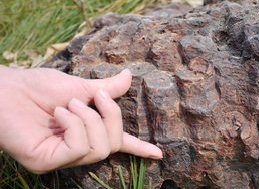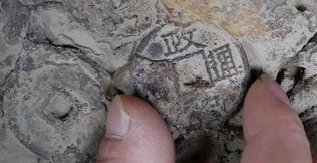A Chinese newspaper reported today that several tons of iron coins dating from the Song Dynasty were recently discovered in a field near the city of Cangzhou (沧州), Hebei Province in northeast China. Although the coins protruding through the soil have rusted together, they can still be seen just the way they were arranged in stacks almost a 1,000 years ago.

Stacks of iron coins from the Song Dynasty
An outcropping of the pile of neatly stacked iron coins can be seen in the photo at the left.
This was not the first time a large quantity of coins had been discovered in the area. In July 1997, at a location just 500 meters from the newly discovered pile of coins, more than 48 tons of Song Dynasty iron coins were unearthed.
The actual quantity of coins discovered in the new “pile” is not known at this time. Based on preliminary calculations, the coins fill an area approximately 25 meters by 16 meters. The top of the pile is about 0.4-0.5 meters below the surface. Since it is not known how deep the pile is, the experts can only estimate that there are several tons of coins.

Chinese iron coin from 1101-1125 AD
The photo at the left displays one of the iron coins from the pile of coins discovered in 1997.
This round cash coin with a square hole in the center has the inscription zheng he tong bao (正和通寶) which was used on coins cast during the reign (1101-1125 AD) of Emperor Hui Zong of the Northern Song Dynasty.
Mr. Yang Fengling (杨凤岭), the Director of the Cang Prefecture Cultural Relics Institute, said it is not yet known if there is any connection between the newly discovered pile of coins and the coins discovered nearby in 1997.
As to why such a large quantity of Song Dynasty coins might exist, Mr. Yang could only conjecture at this time.
Mr. Yang said that during the Song Dynasty, Cangzhou was one of the places where prisoners were sent. During ancient times, prison labor was sometimes used to produce coins. It is possible that this had been the site of a coin foundry or mint.
Mr. Yang also pointed out that the coins seem to have been arranged in a very orderly manner and that the site may have been a large-scale treasury where money was stored.
Mr. Yang mentioned one other interesting possibility. It is said that after Emperor Taizu (960-976) established the Song Dynasty, he wanted to redeem parts of present day Hebei Province, known then as the “Sixteen States of You Yun” (幽云十六州), which were occupied by the Khitan (契丹) of the Liao Dynasty (辽朝). Cangzhou happened to be situated right at the border of the Song and Liao territories and the cache of coins may have been intended for this purpose.
Mr. Yang further stated that this new discovery of iron coins might rewrite history. According to historical sources, iron coins during the Song Dynasty were made and circulated in the southern part of the country. The discovery of such a large quantity of iron coins in the north means that iron coins must have circulated here as well. They may also have been produced here.
Mr. Yang hopes that the mysteries surrounding this new discovery may be better explained once excavation of the site begins next month.